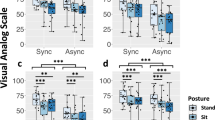Abstract
Several navigation situations can be imagined where visual cueing is not practical or unfeasible, and where the hands are required exclusively for a certain task. The utilization of the sense of touch, as relatively new notification modality, should provide sufficient possibilites to cope with this issue.
The focus in this research work is on two questions (i) how the distance encoding schemas affects the overall navigation speed (or in more detail to what level the time lag contributes to the navigation precision) and (ii) if, beside the vibro-tactile stimulation, the transmission of the noise generated by the individual vibration elements influences the speed and/or precision of route guiding. To deal with these questions we have defined and conducted three waypoint following experiments with two different tactor activation methods, one without and the other two with the distance encoded in the vibration patterns. Additionally, we did studies where we masked the noise of the vibration elements and compared the results against the general setting where masking was not applied.
Our results shows that notification latency led to an increasing number of walking anomalies and consequently affects the walking precision and time to a high degree. Furthermore, we could not find evidence that multimodal stimulation with both vibration force and vibration “noise” tends to result in an increased system performance compared to the system with unimodal feedback using vibrations only.
Preview
Unable to display preview. Download preview PDF.
Similar content being viewed by others
References
van der Heijden, A.H.C., Bem, S.: Eye movements and attention. Consciousness and Cognition 6(2-3), 437–440 (1997), Article No. CC970308
Broadbent, D.E.: Perception and communication. Pergamon, London (1958)
Mayer, R.E., Moreno, R.: Nine Ways to Reduce Cognitive Load in Multimedia Learning. Educational Psychologist 38(1), 43–52 (Winter 2003)
van der Heijden, A.H.C.: Selective Attention in Vision, illustrated edn. Routledge, New York (1992)
Hsia, H.: The information processing capacity of modality and channel performance. Educ. Technology Research and Development 19(1), 51–75 (1971)
Riener, A.: Sensor-Actuator Supported Implicit Interaction in Driver Assistance Systems. PhD thesis, Johannes Kepler University, Linz, Austria (January 2009)
Veen, H.A.V., Erp, J.B.V.: Providing Directional Information with Tactile Torso Displays. In: Proceedings of EuroHaptics 2003, TNO Human Factors Soesterberg, The Netherlands. LNCS, pp. 471–474. Springer, Heidelberg (2003)
Jones, L.A., Lockyer, B., Piateski, E.: Tactile display and vibrotactile pattern recognition on the torso. Advanced Robotics 20(12), 1359–1374 (2006)
Lindeman, R.W., Yanagida, Y., Sibert, J.L., Lavine, R.: Effective vibrotactile cueing in a visual search task. In: Rauterberg, M., Menozzi, M., Wesson, J. (eds.) Proceedings of 13th International Human-Computer Interaction (INTERACT 2003), pp. 89–96. IOS Press, Amsterdam (2003)
van Erp, J.B.: Presenting directions with a vibrotactile torso display. Ergonomics, Taylor and Francis Ltd. 48(3), 302–313 (2005)
Lindeman, R.W., Page, R., Yanagida, Y., Sibert, J.L.: Towards full-body haptic feedback: the design and deployment of a spatialized vibrotactile feedback system. In: VRST 2004: Proceedings of the ACM symposium on Virtual reality software and technology, pp. 146–149. ACM, New York (2004)
Lindeman, W., Yanagida, Y., Noma, H., Hosaka, K.: Wearable vibrotactile systems for virtual contact and information display. Virtual Real. 9(2), 203–213 (2006)
Elliott, L.R., Redden, E.S., Pettitt, R.A., Carstens, C.B., van Erp, J., Duistermaat, M.: Tactile Guidance for Land Navigation. Technical Report ARL-TR-3814, Army Research Laboratory, Aberdeen Proving Ground, MD 21005-5425 (2006)
Wickens, C.D.: Processing resources in attention. In: Parasuraman, R. (ed.) Varieties of Attention, pp. 63–97. Academic Press, New York (1984)
Duistermaat, M.: Tactile Land Navigation in Night Operations. Technical report, TNO Defence, Security and Safety Kampweg 5 3769 ZG Soesterberg, The Netherlands, R&D No. 9954-AN-01 (December 2005)
Tsukada, K., Yasumura, M.: ActiveBelt: Belt-Type Wearable Tactile Display for Directional Navigation. In: Davies, N., Mynatt, E.D., Siio, I. (eds.) UbiComp 2004. LNCS, vol. 3205, pp. 384–399. Springer, Heidelberg (2004)
van Erp, J.B., van Veen, H.A., Jansen, C., Dobbins, T.: Waypoint navigation with a vibrotactile waist belt. ACM Trans. Appl. Percept. 2(2), 106–117 (2005)
Ferscha, A., Emsenhuber, B., Riener, A., Holzmann, C., Hechinger, M., Hochreiter, D., Franz, M., Zeidler, A., dos Santos Rocha, M., Klein, C.: Vibro-Tactile Space-Awareness. In: Adjunct Proceedings of the 10th International Conference on Ubiquitous Computing (Ubicomp 2008), Seoul, South Korea, September 2008, pp. 117–120 (2008), Video paper
Riener, A., Ferscha, A.: Raising awareness about space via vibro-tactile notifications. In: Roggen, D., Lombriser, C., Tröster, G., Kortuem, G., Havinga, P. (eds.) EuroSSC 2008. LNCS, vol. 5279, pp. 235–245. Springer, Heidelberg (2008)
Cholewiak, R.W., Brill, C.J., Schwab, A.: Vibrotactile localization on the abdomen: Effects of place and space. In: Perception and Psychophysics, vol. 66, pp. 970–987 (2004)
Krebs, K.M.: Illumination and division (2009), http://www.restingbell.net/releases/rb009-symmetries (last retrieved March 20, 2009)
Kosinski, R.J.: A Literature Review on Reaction Time. Clemson University, Department of Biological Sciences (September 2009), http://biology.clemson.edu/bpc/bp/Lab/110/reaction.htm (last retrieved January 15, 2009)
Dane, S., Erzurumluoglu, A.: Sex and handedness differences in eye-hand visual reaction times in handball players. International Journal of Neuroscience 113, 923–929 (2003)
Der, G., Deary, I.J.: Age and Sex Differences in Reaction Time in Adulthood: Results From the United Kingdom Health and Lifestyle Survey. Psychology and Aging 21(1), 62–73 (2006)
Surnina, O.E., Lebedeva, E.V.: Sex- and Age-Related Differences in the Time of Reaction to Moving Object in Children and Adults. Human Physiology 27(4), 436–440 (2001)
Author information
Authors and Affiliations
Editor information
Editors and Affiliations
Rights and permissions
Copyright information
© 2009 Springer-Verlag Berlin Heidelberg
About this paper
Cite this paper
Riener, A., Straub, M., Ferscha, A. (2009). Time-Lag as Limiting Factor for Indoor Walking Navigation. In: Barnaghi, P., Moessner, K., Presser, M., Meissner, S. (eds) Smart Sensing and Context. EuroSSC 2009. Lecture Notes in Computer Science, vol 5741. Springer, Berlin, Heidelberg. https://doi.org/10.1007/978-3-642-04471-7_3
Download citation
DOI: https://doi.org/10.1007/978-3-642-04471-7_3
Publisher Name: Springer, Berlin, Heidelberg
Print ISBN: 978-3-642-04470-0
Online ISBN: 978-3-642-04471-7
eBook Packages: Computer ScienceComputer Science (R0)




